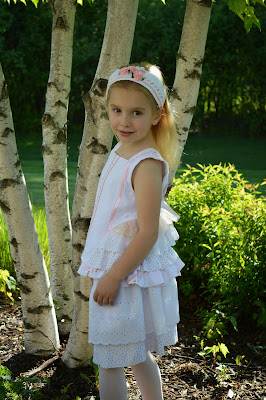Girlie-Girl
Adjective: Adding ruffles, lace, ribbon, tulle, soft colors, and combining those elements for a feminine feel Girlie Girl Ruffled Top, Skirt, and Headband
 |
| Rick rack over back yoke seam with fabric loops slit opening |
(I just couldn't help myself as ideas just kept running though my head of ways to adapt this pattern.)
When I made the Stripes and Flounces shirt, I created changes in the original pattern that kept the center front of the shirt flat, but added flared out flounces in the back and front sides. So I used this same idea, but left the rounded cut-outs flat and filled them with ruffles on both the side front and lower back of the shirt.
Toile Print Ribbon
Eyelet Lace
Rosebud Gauze Fabric
White Batiste with ribbons,rickrack, and tucks
This shirt is completely lined with a soft white knit fabric from Riley Blake. Why? My granddaughter has super sensitive skin issues (eczema) and I knew that all those ruffle layers rubbing her skin would not be comfortable for her.

The last ruffle on the shirt goes completely around the shirt and is attached to the knit lining.
The top of the skirt, that touches Miss C's waist, is made from this soft knit also. I've learned that when you sew a garment for someone you must consider both
the beauty of the design and the comfort of the feel.
And lastly... add a bit of frosting to the outfit.


Smiles,
Deborah
P. S. The sewing lesson with Miss E and Me on Friday will be about adding a gathered ruffle.

The last ruffle on the shirt goes completely around the shirt and is attached to the knit lining.
The top of the skirt, that touches Miss C's waist, is made from this soft knit also. I've learned that when you sew a garment for someone you must consider both
the beauty of the design and the comfort of the feel.


Smiles,
Deborah
P. S. The sewing lesson with Miss E and Me on Friday will be about adding a gathered ruffle.





















































